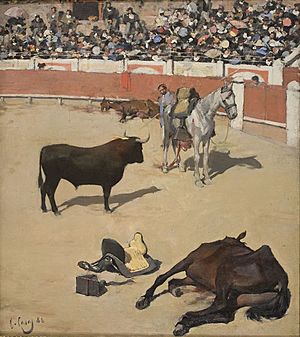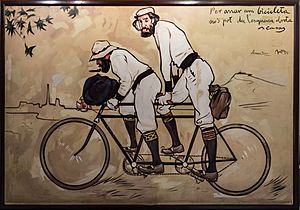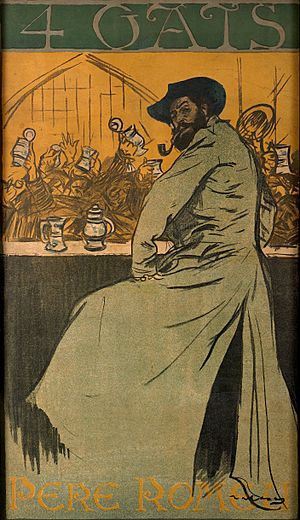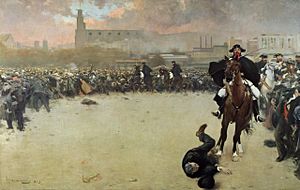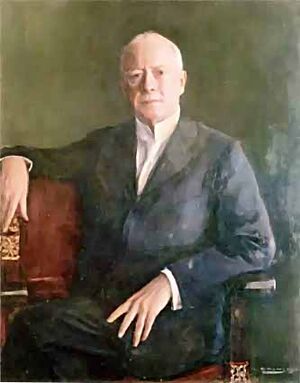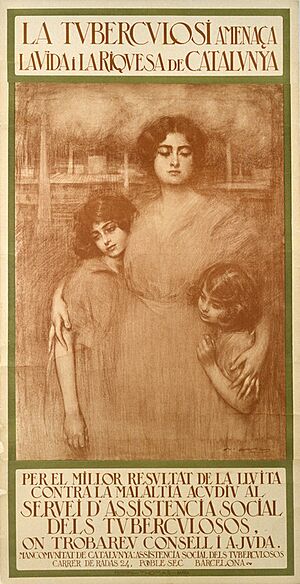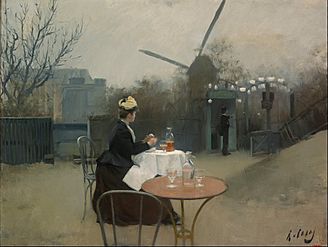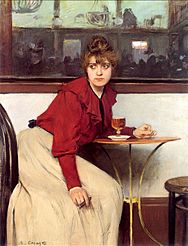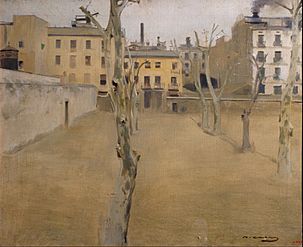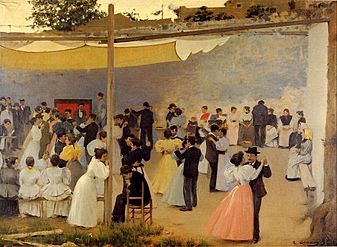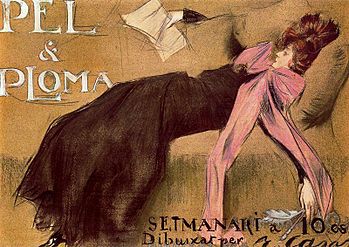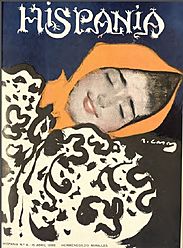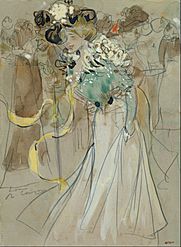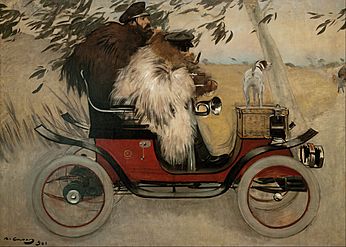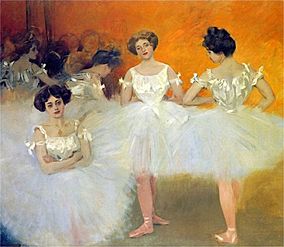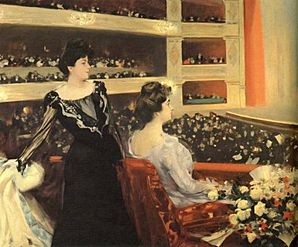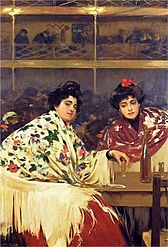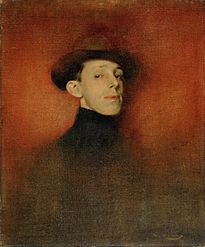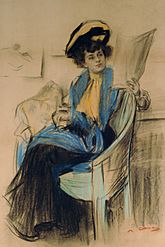Ramon Casas facts for kids
Quick facts for kids
Ramon Casas
|
|
|---|---|
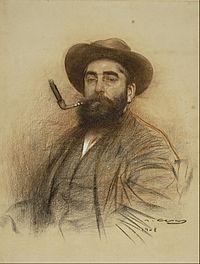
Self-portrait, 1908
|
|
| Born |
Ramon Casas i Carbó
4 January 1866 Barcelona, Spain
|
| Died | 29 February 1932 (aged 66) Barcelona, Spain
|
| Known for | Painting |
| Movement | Modernisme |
Ramon Casas i Carbó (born January 4, 1866 – died February 29, 1932) was a famous Spanish artist. He lived during a time of big changes in his hometown, Barcelona. Ramon Casas was known for painting and sketching important people. These included leaders, rich business owners, and thinkers from Barcelona, Paris, Madrid, and other places.
He also painted large crowd scenes. These could be people watching a bullfight or crowds during important events in the streets of Barcelona. Casas was also a graphic designer. His posters and postcards helped define a special art style called modernisme in Catalonia.
Contents
Early Life and Art in Barcelona and Paris
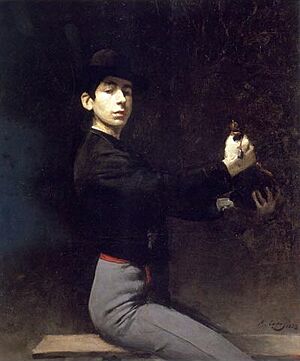
Ramon Casas was born in Barcelona. His father had become wealthy in Matanzas, Cuba. His mother came from a rich family in Catalonia, Spain. In 1877, when he was 11, Ramon stopped regular school to study art. He learned in the studio of a painter named Joan Vicens.
In 1881, still a teenager, he helped start a magazine called L'Avenç. One issue even featured his sketch of a old monastery. In the same month, he went to Paris for the first time with his cousin. There, he studied art at famous academies. He also sent news from Paris back to L'Avenç magazine.
The next year, one of his paintings was shown in Barcelona. In 1883, a painting of himself dressed as a flamenco dancer was shown in Paris. This painting was so good that he was invited to become a member of a famous art group, the Societé d'artistes françaises.
For the next few years, Ramon kept painting and traveling. He spent most autumns and winters in Paris. The rest of the year he was in Spain, mainly Barcelona, but also in Madrid and Granada. His 1886 painting of a crowd at a bullfight in Madrid was the first of many detailed crowd scenes he would paint. That year, he got sick with tuberculosis but recovered. He spent the winter getting better in Barcelona. During this time, he met and was influenced by other artists like Santiago Rusiñol and Ignacio Zuloaga.
In 1889, Casas and Rusiñol traveled through Catalonia. They worked together on a small book. Rusiñol wrote the words, and Casas drew the pictures. They then moved to Paris and lived together in a famous area called Montmartre. They shared a place with other artists. Rusiñol wrote about their adventures in a newspaper, and Casas drew pictures for the articles. Casas became a special member of the Societé d'artistes françaises. This meant he could show two artworks each year without needing a jury to approve them.
In 1890, Casas, Rusiñol, and a sculptor named Enric Clarasó had an art show in Barcelona. Casas's paintings from this time mixed traditional art with the new French impressionism style. The modernisme art style was just starting to form. Key artists were meeting, and successful Catalan artists began to feel more connected to Barcelona than to Paris.
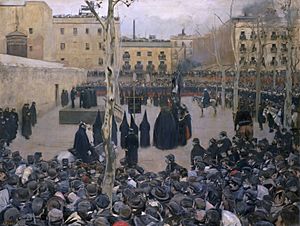
Ramon Casas's fame grew across Europe and beyond. He showed his art in Madrid (1892, 1894), Berlin (1891, 1896), and even at a big exhibition in Chicago (1893). Meanwhile, the group of artists including Casas and Rusiñol started holding their own shows more often in Barcelona and Sitges. Because of all this activity in Catalonia, he spent more time in Barcelona. However, he still traveled to Paris for the yearly art shows.
Els Quatre Gats: A Special Meeting Place
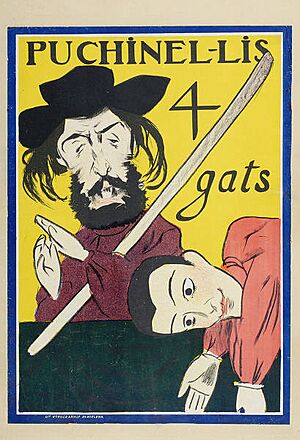
The new modernista art movement found a home when Els Quatre Gats (meaning "The Four Cats") opened. This was a bar in Barcelona, like the famous "Le Chat Noir" in Paris. Ramon Casas helped pay for most of this bar. It was on the ground floor of a building designed by Architect Josep Puig i Cadafalch. The bar opened in June 1897 and stayed open for six years. His partners in the bar were Pere Romeu, who managed the place, and artists Rusiñol and Miquel Utrillo.
The bar was a place for artists and thinkers to meet and talk. It also had changing art shows. One of the first solo shows by the famous artist Pablo Picasso was held there. The most famous painting in the bar was a fun self-portrait by Casas. It showed him smoking a pipe while riding a tandem bicycle with Pere Romeu. The original painting is now in a museum in Barcelona.
Like the Paris bar, Els Quatre Gats tried to have its own magazine about art and writing. Casas contributed a lot to it. This magazine didn't last long, but it was followed by others like Pèl & Ploma and Forma, to which Casas also contributed. Pèl & Ploma helped organize several important art shows. This included Casas's own successful first solo show in 1899. It showed his oil paintings and charcoal sketches of famous people in Barcelona.
While his painting career was doing well, Casas also worked a lot as a graphic designer because he owned part of the bar. He used the art nouveau style, which became a key part of modernisme. He designed posters for the café, often showing Pere Romeu. He also created advertisements for a brand of Spanish sparkling wine called cava. Over the next ten years, he designed posters for many different products.
Growing Fame and New Connections
For the big 1900 Exposition Universelle (1900) in Paris, Spain chose two of Casas's full-length portraits to display. One was of the composer Erik Satie from 1891, and the other was of Casas's sister Elisa from 1895. His 1894 painting Garrote vil, which showed an execution, won a major award in Munich in 1901. His art was shown in major cities across Europe and even as far as Buenos Aires, Argentina. In 1902, twelve of his paintings were permanently placed in a special room of the Cercle de Liceu. This was an exclusive club linked to Barcelona's famous opera house.
In 1903, he became a full member of a major art show in Paris, which meant he could exhibit there every year. However, he only showed his work there for two more years. In 1903, his painting for the show was originally called La Carga (The Charge). He renamed it Barcelona 1902 to refer to a recent big strike. However, the painting, which shows police breaking up a crowd, had actually been painted at least two years before that strike. In 1904, the same painting won first prize at a big exhibition in Madrid.
During a visit to Madrid in 1904, he drew many sketches of important thinkers there. He also became friends with painters Eliseu Meifrèn and Joaquín Sorolla. In the studio of a famous sculptor, he painted a portrait of the king, Alfonso XIII, on horseback. This painting was soon bought by an American art collector named Charles Deering. Over the next few years, Deering would buy or ask Casas to paint several more artworks.
Júlia Peraire: A Special Model
Ramon Casas was becoming more and more popular for his portraits. He settled back in Barcelona for a while. Soon after, he met a young artist's model named Júlia Peraire. She was 22 years younger than him. He first painted her in 1906 when she was 18. She quickly became his favorite model and his girlfriend. His family did not approve of their relationship. They eventually got married, but not until 1922.
Patronage and Travel
Casas's mother bought an old monastery called Sant Benet de Bages in 1907. She hired the architect Puig i Cadafalch to fix it up. Casas spent a lot of time there and often painted the monastery and its surroundings. Five years later, when his mother passed away, he inherited the monastery.
In 1908, Casas and his patron, Charles Deering, traveled through Catalonia. Deering bought an old hospital in Sitges to turn it into a home. Later that year, Casas went on a six-month trip to Cuba and the United States. Deering invited him. During this trip, Casas painted many oil portraits and charcoal drawings of Deering's friends and business partners.
When he returned to Spain in April 1909, he had solo art shows in Barcelona and Madrid. In Barcelona, he showed 200 charcoal sketches, which he then gave to the Barcelona Museum. His show in Madrid featured portraits of important people from the city, including the king.
His life continued with many travels and exhibitions. In 1910, he painted the funeral of his friend, the art critic Raimon Casellas. He also painted a second version of La Carga for Deering. This time, it showed a police officer on foot instead of on horseback. Before World War I, he traveled a lot in Spain and Europe, sometimes alone and sometimes with Deering. He visited many cities and countries. He continued to have major art shows in Spain and France. In 1913, he bought a beautiful home in Barcelona. In 1915, he, Rusiñol, and Clarassó had another joint exhibition, celebrating 25 years since their first one.
Later Years and Legacy
In 1916, Casas and Deering traveled to Tamarit in Catalonia. Deering bought the entire village and put Casas in charge of restoring it. Several years later, in 1924, Casas returned to Tamarit to paint many landscapes. Also in 1916, Deering bought a house in Sitges, which is now a museum. A magazine dedicated an issue to Casas.
Casas had stayed away from the conflicts of World War I. But in 1918, he visited the front lines. He painted a self-portrait wearing a military cape.
Casas, Rusiñol, and Clarasó started having regular yearly art shows together again in 1921. These continued until Rusiñol's death in 1931. However, that year, Casas had a disagreement with his friend Utrillo because of Casas's close friendship with Deering. They never became friends again.
In 1922, Casas finally married Júlia Peraire. In 1924, she went with him on a trip to the United States. There, he once again painted portraits of rich and famous people.
By the 1920s, Casas's art style had become less modern than it was when he was younger. His work from this time looked more like that of an older, traditional painter. He continued to paint landscapes and portraits. He also designed posters, including ones to fight tuberculosis. By the time he passed away in 1932, he was seen more as an artist from the past.
Selected Works
See also
 In Spanish: Ramón Casas para niños
In Spanish: Ramón Casas para niños


